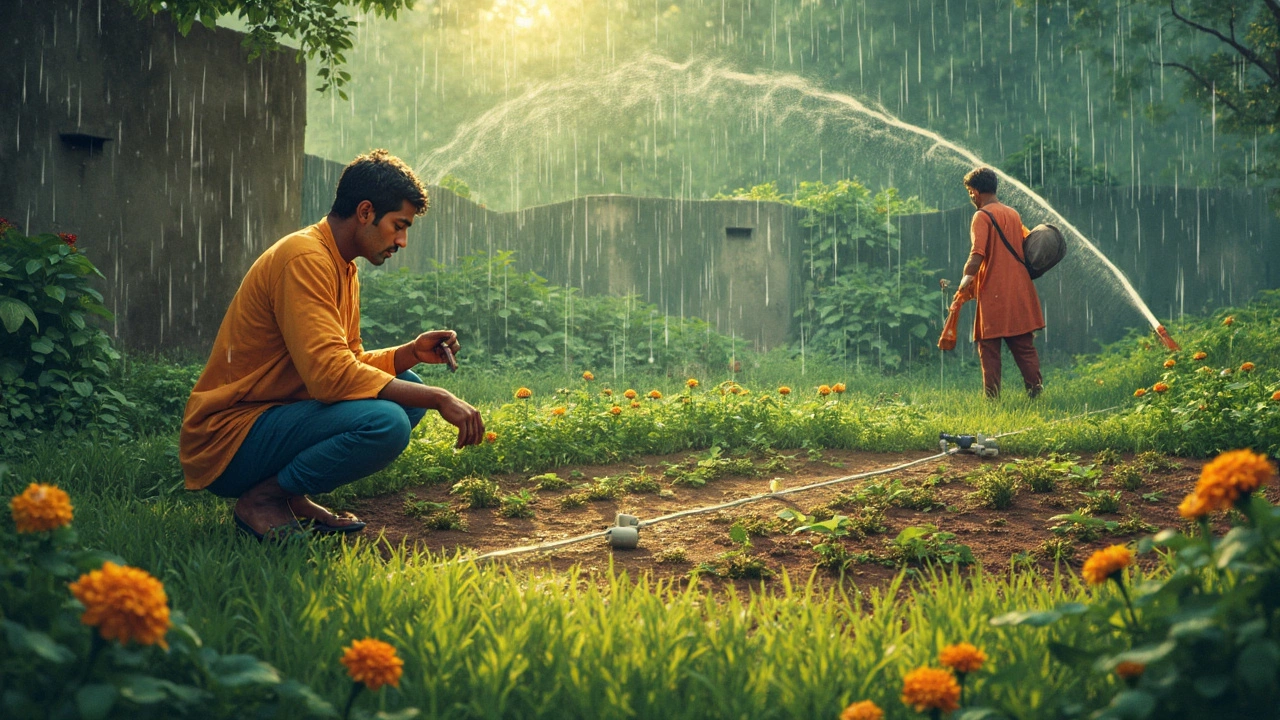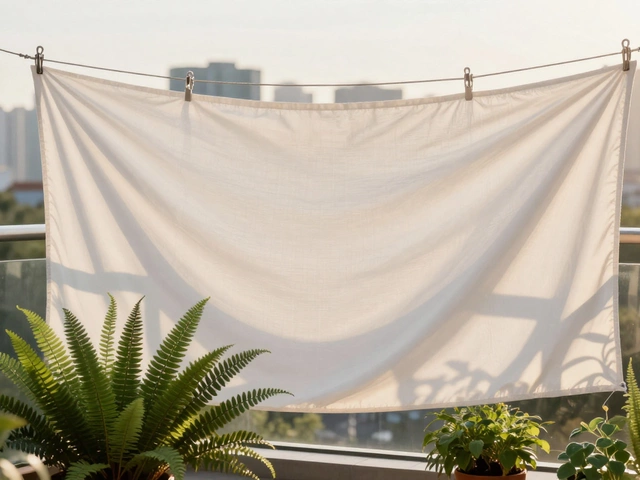If you’ve ever battled with a tangled hose or watched your grass wilt during a hot week, you’re not alone. Underground sprinklers promise to fix all that. But before you start dreaming about lush lawns without effort, there’s a lot you should know—because these systems are not all sunshine and roses.
Let’s keep it real: laying pipes under your yard is a serious project. From the digging to the planning where each sprinkler goes, it’s not like sticking a soaker hose around a flower bed. Plus, the cost isn’t just the price of parts—labor, permits, and even fixing any broken heads later add up fast.
- How Underground Sprinklers Work
- Cost Breakdowns vs. Drip Systems
- Water Usage and Efficiency
- Maintenance and Daily Life
How Underground Sprinklers Work
If you're curious about underground sprinklers, let's break it down in a way that's straightforward and practical. These systems are a network of pipes buried in your yard, hooked up to sprinkler heads that pop up when it’s time to water. The magic starts with a control box—usually mounted in your garage or outside wall. You program it for when and how long each zone gets water. Once the timer triggers, an electric signal opens valves, water flows through pipes, and up pop the sprinkler heads. Once that cycle finishes, the heads duck back underground out of sight until next time.
Most folks split their lawn into "zones" so each area gets just the right amount of water. You don’t want flower beds soaking as much as thick grass. The control box can run each zone on a different schedule. Many control boxes come with rain sensors or soil moisture readers. If it rains or your ground’s already soaked, the system just skips a cycle, saving water and money.
Here’s a simple rundown of what makes up a typical system:
- Control Box: The "brain" that handles programming and timing.
- Valves: These open or close to let water into different zones.
- Pipes: Usually PVC, these carry water underground to the right spots.
- Sprinkler Heads: Pop up to spray water then go back down, so you don't trip on them mowing.
- Backflow Preventer: Keeps dirty water from getting into your clean water supply—required by most city codes.
One quick fact: On a standard quarter-acre suburban lot, the average underground sprinklers system needs about 6–8 zones and uses up to 2,500–3,000 gallons of water during a full cycle. That’s a lot more than a typical drip irrigation setup, which is why folks looking to save on water bills sometimes steer toward drips and soakers.
Cost Breakdowns vs. Drip Systems
Let’s get right into the money part—because underground sprinklers aren’t cheap. Not even close. On average, a pro-installed system for a quarter-acre lot runs anywhere from $2,500 to $4,000. If you've got a bigger yard, or want top-notch gear like smart controllers, expect that price to jump. Cutting corners with cheaper parts often means more repairs down the road.
Now compare that to a drip irrigation setup. For the same area, even a decent drip system lands somewhere between $300 and $700 if you’re doing it yourself. Pro installation might double that, but it’s still nowhere near what sprinklers cost. The parts add up mostly from tubing, emitters, filters, and a simple timer. There’s barely any digging or lawn repair afterward.
| System Type | Do-It-Yourself | Professional Install |
|---|---|---|
| Drip Irrigation | $150-$700 | $500-$1,500 |
| Underground Sprinklers | $600-$2,000 | $2,500-$5,000 |
But here's the thing: with underground sprinklers, you’re not done when the installers leave. Stuff breaks. Heads get clogged or damaged by lawnmowers. Winter shuts everything down unless you pay for blowout service. Parts and fixes cost extra—sometimes every season. Drip lines aren’t bulletproof either, but they tend to be easier and cheaper to patch up yourself. Most repairs don’t even require digging.
- Lawn repair: After putting in sprinklers, your grass will look like a gopher army paid a visit. Some folks forget to budget for reseeding or sod.
- Water bills: Big surprise here—underground sprinklers can use more water on lawns compared to drip systems in garden beds. That shows up when you get the bill.
- Timers and smart tech: Modern systems offer smart controllers for both, so you can set schedules from your phone. Just know the upcharge is usually higher with sprinklers.
Bottom line: if you’re installing a system just for a veggie patch or flower beds, drip wins hands down for cost and simplicity. If it’s a whole-lawn, big-yard dream, be ready for the steeper underground sprinklers price tag—plus extras most people never factor in.

Water Usage and Efficiency
Folks tend to think putting in underground sprinklers means they’ll instantly use less water and lower their bills. That’s only true if the system is designed well and set up for your yard—not just dragged out of a one-size-fits-all box. The truth is, a badly planned system can waste loads of water, especially if your sprinklers are spraying sidewalks or overlapping too much, which happens more than you’d think.
If you’re comparing this to a drip irrigation setup, there’s a big difference. Drip systems feed water right to plant roots using slow, steady drips. This is super efficient—almost no water lost to wind or evaporation. Most of the time, drip irrigation uses between 30% and 50% less water than standard sprinklers. That means a lot, especially if you’re in a drought-prone area or want to keep bills predictable.
Modern underground sprinklers do better now thanks to tech like smart timers, rain sensors, and adjustable heads. These upgrades keep water from running during rainstorms or at times of day when evaporation is worst. Still, you have to keep them clean and adjusted, or you’ll end up watering more of your driveway than your grass.
Just to see the differences stacked up, check this out:
| System | Average Water Use (per hour/zone) | Water Loss (Wind/Evaporation) |
|---|---|---|
| Traditional Sprinklers | ~1,000 gallons | 30%-50% |
| Underground Sprinklers (with smart controls) | 700-900 gallons | 10%-30% |
| Drip Irrigation | 200-400 gallons | Less than 10% |
If you care about squeezing every last drop out of your system, drip irrigation usually comes out ahead—especially for garden beds. But for lawns, underground sprinklers work better than trying to move hoses around by hand. Just pay attention to the setup, run it early mornings, and keep the heads clean for best results.
Maintenance and Daily Life
Once you’ve got underground sprinklers in, daily life sounds dreamy: just set the timer and go about your day. But let’s talk about the reality of keeping them running. Even the best underground sprinklers need attention, and ignoring them leads to brown patches, wasted water, or surprise repair bills.
First off, sprinkler heads are ground-level targets for lawnmowers, soccer balls, and dogs who dig. Heads get clogged, crack, or start spraying crooked. A quick check every few weeks saves headaches. Expect to replace a few heads each season if your yard gets a lot of action.
Leaks can be sneaky. A small split in a pipe underground won’t show until your water bill leaps or the grass above turns into a swamp. Some people install pressure sensors to catch leaks early, but most just keep an eye out for soggy spots.
- Spring startup: Blowing out lines to clear any leftover water, checking for burst pipes, and cleaning each head is a must.
- Fall shut down: Draining and winterizing keeps the system from freezing and cracking, especially anywhere north of Texas.
Timers and controllers are the brains of your watering system. Tech has come a long way—some timers now link to weather apps or soil moisture sensors. But anything electronic outside can glitch. Batteries die, wiring corrodes, and power outages reset your schedule. A glance at your timer now and then keeps things regular.
| Task | How often? | Typical Cost |
|---|---|---|
| Check heads for clogs/damage | Every 2-4 weeks | $2-7 per head |
| Blow out lines (winterize) | Yearly | $60-120 (professional) |
| Fix pipe leaks | As needed | $50-200 per repair |
Compared to drip irrigation, which is usually easier to check and fix, underground sprinklers are a bit more “out of sight, out of mind.” That makes them convenient but also easy to forget until something goes wrong. Mark your calendar to run a test cycle every month—it only takes ten minutes but can prevent a headache later on.
If you’re not into DIY, budget for a service visit at least once a year. Otherwise, keep an eye out for stuck zones, random puddles, or timers that don’t match your needs. Staying ahead on maintenance keeps the system worth the money and hassle.





